Files in this item
Comparing the performances of apes (Gorilla gorilla, Pan troglodytes, Pongo pygmaeus) and human children (Homo sapiens) in the floating peanut task
Item metadata
| dc.contributor.author | Hanus, Daniel | |
| dc.contributor.author | Mendes, Natacha | |
| dc.contributor.author | Tennie, Claudio | |
| dc.contributor.author | Call, Josep | |
| dc.date.accessioned | 2014-04-24T12:01:02Z | |
| dc.date.available | 2014-04-24T12:01:02Z | |
| dc.date.issued | 2011-06-08 | |
| dc.identifier | 104086093 | |
| dc.identifier | b3fc69e4-31df-4354-ae2d-f1fed963083e | |
| dc.identifier | 000291611500003 | |
| dc.identifier | 79958152026 | |
| dc.identifier.citation | Hanus , D , Mendes , N , Tennie , C & Call , J 2011 , ' Comparing the performances of apes ( Gorilla gorilla, Pan troglodytes, Pongo pygmaeus ) and human children ( Homo sapiens ) in the floating peanut task ' , PLoS ONE , vol. 6 , no. 6 , 19555 . https://doi.org/10.1371/journal.pone.0019555 | en |
| dc.identifier.issn | 1932-6203 | |
| dc.identifier.other | ORCID: /0000-0002-8597-8336/work/37477811 | |
| dc.identifier.uri | https://hdl.handle.net/10023/4591 | |
| dc.description | There is no current external funding source. The internal funders (MPI) had no role in study design, data collection and analysis, decision to publish or preparation of the manuscript | en |
| dc.description.abstract | Recently, Mendes et al. [1] described the use of a liquid tool (water) in captive orangutans. Here, we tested chimpanzees and gorillas for the first time with the same "floating peanut task." None of the subjects solved the task. In order to better understand the cognitive demands of the task, we further tested other populations of chimpanzees and orangutans with the variation of the peanut initially floating or not. Twenty percent of the chimpanzees but none of the orangutans were successful. Additional controls revealed that successful subjects added water only if it was necessary to obtain the nut. Another experiment was conducted to investigate the reason for the differences in performance between the unsuccessful (Experiment 1) and the successful (Experiment 2) chimpanzee populations. We found suggestive evidence for the view that functional fixedness might have impaired the chimpanzees' strategies in the first experiment. Finally, we tested how human children of different age classes perform in an analogous experimental setting. Within the oldest group (8 years), 58 percent of the children solved the problem, whereas in the youngest group (4 years), only 8 percent were able to find the solution. | |
| dc.format.extent | 13 | |
| dc.format.extent | 262169 | |
| dc.language.iso | eng | |
| dc.relation.ispartof | PLoS ONE | en |
| dc.subject | Tool-Use | en |
| dc.subject | Functional Fixedness | en |
| dc.subject | Cumulative Culture | en |
| dc.subject | Caledonian Crows | en |
| dc.subject | Archer Fish | en |
| dc.subject | Chimpanzees | en |
| dc.subject | Orangutans | en |
| dc.subject | Evolution | en |
| dc.subject | Cognition | en |
| dc.subject | QL Zoology | en |
| dc.subject.lcc | QL | en |
| dc.title | Comparing the performances of apes (Gorilla gorilla, Pan troglodytes, Pongo pygmaeus) and human children (Homo sapiens) in the floating peanut task | en |
| dc.type | Journal article | en |
| dc.contributor.institution | University of St Andrews. School of Psychology and Neuroscience | en |
| dc.contributor.institution | University of St Andrews. Centre for Social Learning & Cognitive Evolution | en |
| dc.identifier.doi | https://doi.org/10.1371/journal.pone.0019555 | |
| dc.description.status | Peer reviewed | en |
This item appears in the following Collection(s)
Items in the St Andrews Research Repository are protected by copyright, with all rights reserved, unless otherwise indicated.

